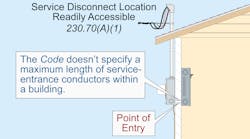Stumped by the Code? NEC Rules for Mounting Equipment on Trees and Other Vegetation
All questions and answers are based on the 2017 NEC.
Underlined text indicates a Code change.
Q. Does the NEC allow service equipment to be mounted on trees or other vegetation?
A. Trees or other vegetation aren’t permitted to be used for the support of overhead service conductor spans or service equipment [Sec. 230.10].
Service‑drop conductors installed by the electric utility must comply with the National Electrical Safety Code (NESC), not the National Electrical Code (NEC) [Sec. 90.2(B)(5)]. Overhead service conductors that aren’t under the exclusive control of the electric utility must be installed in accordance with the NEC.
Q. What wiring methods does the Code allow for service-entrance conductors?
A. Service-entrance conductors can be installed with any of the following wiring methods [Sec. 230.43]:
(1) Open wiring on insulators
(3) Rigid metal conduit (RMC)
(4) Intermediate metal conduit (IMC)
(5) Electrical metallic tubing (EMT)
(6) Electrical nonmetallic tubing (ENT)
(7) Service-entrance cables
(8) Wireways
(9) Busways
(11) PVC conduit
(13) Type MC cable
(15) Flexible metal conduit (FMC) or liquidtight flexible metal conduit (LFMC) in lengths not longer than 6 ft
(16) Liquidtight flexible nonmetallic conduit (LFNC)
(17) High-density polyethylene conduit (HDPE)
(18) Nonmetallic underground conduit with conductors (NUCC)
(19) Reinforced thermosetting resin conduit (RTRC)
Q. What are the NEC requirements for service disconnects?
A. The service disconnect must open all ungrounded service-entrance conductors from the building premises wiring [Sec. 230.70].
(A) Location.
(1) Readily accessible. The service disconnecting means must be placed at a readily accessible location either outside the building or inside nearest the point of service conductor entry (see Figure).
WARNING: Because service-entrance conductors don’t have short-circuit or ground-fault protection, they must be limited in length when installed inside a building. Some local jurisdictions have a specific requirement as to the maximum length permitted within a building.
(2) Bathrooms. The service disconnect isn’t permitted to be installed in a bathroom.
(3) Remote control. If a remote-control device (such as a pushbutton for a shunt-trip breaker) is used to actuate the service disconnect, the service disconnect must be located at a readily accessible location either outside the building, or nearest the point of entrance of the service conductors as required by Sec. 230.70(A)(1).
See the definition of “Remote Control” in Art. 100. The service disconnect must consist of a manually operated switch, a power-operated switch, or a circuit breaker that’s also capable of being operated manually [Sec. 230.76].
(B) Disconnect identification. Each service disconnecting means must be permanently marked to identify it as part of the service disconnecting means.
(C) Suitable for use. Each service disconnect must be suitable for the prevailing conditions.
Q. What is the Code definition of a “tap conductor”?
A. The NEC defines a tap conductor as a conductor, other than a service conductor, that has overcurrent protection rated more than the ampacity of a conductor. See 240.21(A) and Sec. 240.21(B) for details [240.2].





